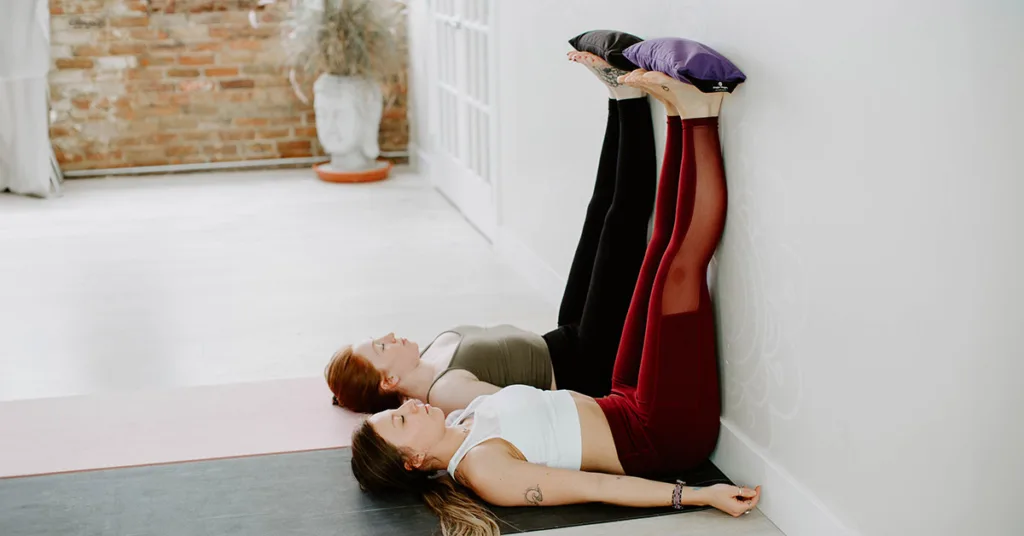This entry was posted on Jan 10, 2024 by Charlotte Bell.

Several years ago, as part of a teacher training I was co-teaching, I demonstrated the problems with squaring your hips in wide-legged standing poses to the trainees. As it turned out, the demonstration was very effective—much to my chagrin. Almost on cue, when I came up out of the pose, I felt a stabbing pain in the right side of my sacroiliac (SI) joint. I limped over to a wall space, and taught for the next 15 minutes from Viparita Karani (Legs-Up-the-Wall), my favorite SI joint reset pose. The pose did its job. When I returned to an upright position, my SI joint felt just fine.
SI joint issues are some of the most common injuries related to yoga practice. There are several reasons for this. First, there’s the anatomically nonsensical “square your hips” instruction in standing poses that so many of us have learned and practiced for years. Then there’s the emphasis on “hip opening” in so many yoga classes. Of course, it’s a good idea to maintain hip joint flexibility, but practicing extreme hip-opening poses without balancing it with hip-strengthening poses can destabilize the SI joint. This can make it prone to injury.
What Is SI Joint Dysfunction?
The SI joint is a joint of “mobile stability.” This means that the joint needs to be stable in order to move force efficiently between the legs and the upper body. The joint needs only a tiny amount of mobility—1 to 3 mm—to make walking more easeful. When we force the pelvis into unnatural positions (re: squaring the hips in standing poses when one hip is flexed and the other is extended), over time, the joint destabilizes. Extreme hip opening also destabilizes the joint because the strong ligaments that hold the joint together become overstretched. Once they’re overstretched, they do not return to their original length. This makes it more difficult for the joint to stay aligned.
There are several ways the SI joint can misalign, causing that stabbing pain I experienced. Here’s a list:
- Anterior rotation of the ilium
- Posterior rotation of the ilium
- Flare (gapping) internally/externally of the ilium
- Rotation of the sacral body
- Superior or inferior slip of the ilium
All these issues grow out of conditions of instability, and most of them are due asymmetry in the joint. Legs-Up-the-Wall is an effective SI joint reset because it encourages the joint to return to symmetry.
How to Practice Viparita Karani for SI Joint Reset
- Gather your props: Yoga Mat, Yoga Sandbag. You can practice this pose without the Yoga Sandbag, but in my experience, the extra weight is really helpful. If you have chronic or even occasional SI joint issues, a sandbag is a great investment.
- Set your Yoga Mat up perpendicular to a wall. Have your sandbag close by. You might want to have a folded Yoga Blanket handy in case you’d like to place it under your head and neck for support.
- Lie down on your mat and extend your legs up the wall, setting up as close to the wall as possible. It’s important that your SI joint be flat against the floor, with your spine in a neutral position. This means that your lumbar spine should be curving slightly away from the floor—not pressing down into the floor. If your lower spine is rounded, scoot away from the wall until your lumbar spine is no longer pressing into the floor.
- Bend your knees, sliding your feet down the wall. Place the sandbag onto the soles of your feet. Then extend your legs back up the wall. Alternatively, if you have a friend or yoga teacher close by, ask them to place the sandbag atop the soles of your feet. Make sure the weight on your feet is even from left to right.
- Relax here for 5 to 10 minutes.
- When you’re ready to leave the pose, slide your feet down the wall. Remove the sandbag and set it aside. Gently draw your knees in toward your chest for a few breaths. Then roll onto your side and return to a seated pose. Take a few breaths in a seated pose, feeling into the hips and SI joint, noticing any changes.
About Charlotte Bell
Charlotte Bell discovered yoga in 1982 and began teaching in 1986. Charlotte is the author of Mindful Yoga, Mindful Life: A Guide for Everyday Practice and Yoga for Meditators, both published by Rodmell Press. Her third book is titled Hip-Healthy Asana: The Yoga Practitioner’s Guide to Protecting the Hips and Avoiding SI Joint Pain (Shambhala Publications). She writes a monthly column for CATALYST Magazine and serves as editor for Yoga U Online. Charlotte is a founding board member for GreenTREE Yoga, a non-profit that brings yoga to underserved populations. A lifelong musician, Charlotte plays oboe and English horn in the Salt Lake Symphony and folk sextet Red Rock Rondo, whose DVD won two Emmy awards in 2010.

